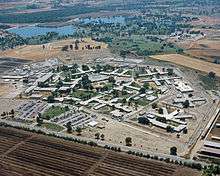California Institution for Women
 Aerial View | |
| Location | Chino, California |
|---|---|
| Coordinates | 33°57′00″N 117°38′06″W / 33.950°N 117.635°WCoordinates: 33°57′00″N 117°38′06″W / 33.950°N 117.635°W |
| Status | Operational |
| Security class | Minimum to medium |
| Capacity | 1,398 |
| Population | 1,819 (130.1%) (as of March 1, 2018[1]) |
| Opened | 1952 |
| Managed by | California Department of Corrections and Rehabilitation |
| Warden | Molly Hill |

California Institution for Women (CIW) is a Women's state prison located in the city of Chino, San Bernardino County, California, east of Los Angeles.
Facilities
Although the official California Department of Corrections and Rehabilitation documents give a mailing address for CIW in the city of Corona in Riverside County,[2] the prison has been physically located in the city of Chino since 2003 following an annexation of land in previously-unincorporated San Bernardino County.[3][4][5]
CIW has 120 acres (49 ha). Its facilities include Level I ("Open dormitories without a secure perimeter") housing, Level II ("Open dormitories with secure perimeter fences and armed coverage") housing, and Level III ("Individual cells, fenced perimeters and armed coverage") housing.[6] In addition, a Reception Center "provides short term housing to process, classify and evaluate incoming inmates."[6]
As of Fiscal Year 2008/2009, CIW had 977 staff and an annual budget of $75 million Institutional and $2.6 million Education.[7] As of October 31, 2013, it had a design capacity of 1,398 but a total institution population of 2,155, for an occupancy rate of 154.1 percent.[8]
CIW s located east of Downtown Los Angeles, and it takes about one hour to travel to the prison from Downtown LA.[9]
History
The original California Institution for Women was dedicated in Tehachapi in 1932; however, after the 1952 Kern County earthquake, the female inmates were transferred to the just-opened CIW in Chino, and the Tehachapi facility was rebuilt as the male-only California Correctional Institution.[10] CIW was originally called "California Institution for Women at Corona," but "Corona residents objected to the use of their city in the prison's name and it was changed March 1, 1962, to Frontera, a feminine derivative of the word frontier, symbolic for a new beginning."[11] It housed the location of the death row for women in the state.[12] CIW was the only women's prison in California until 1987, when the Northern California Women’s Facility opened.[13]
In the early years of CIW, convicted women wore Sunday dresses while walking and working at the campus-like setting until the 1980s when three towers were added with officers atop armed with shotguns.[11] Among other programs for inmates at CIW is "Voices from Within" in which inmates read books on tapes for "high school students in remedial classes," "college students with reading disabilities," and the blind.[14]
The first prison nursery in California opened at CIW in 2006 "to correct what experts call a dangerous disruption of the natural bonding process."[15] It "join[s] newborns with their incarcerated mothers for up to 15 months."[15] In 2007, the state of California proposed building 45 new units for mentally ill inmates at CIW and 975 at the nearby California Institution for Men; local officials opposed such plans.[16]
From 2006 to 2013 one woman at CIW committed suicide. From January 1, 2013 to July 2016 six women committed suicide at CIW, and there had been an increase in suicide attempts.[9]
Notable inmates
- Julia Rodriquez Diaz (First female Inmate to receive 15 years parole denial under Proposition 9 (Marsy's Law) Convicted in July 1979 of the murder of 7-year-old boy Javier Angel. Story told in September 2013 on Discovery Deadly Women "Heartless Souls" (Was recently moved to California Institution for Women (CIW) in 2014)[17][18]
- Betty Broderick, a current inmate, was a San Diego socialite who was convicted of the 1989 murder of her ex-husband, Dan Broderick, and his new wife, Linda Kolkena Broderick. She was convicted in 1991 and was sentenced to 32-years-to-life in prison.
- Barbara Graham, murderer, and subject of the 1958 film I Want to Live!. Graham was subsequently executed at San Quentin State Prison on June 3, 1955.
- Patricia Krenwinkel and Leslie Van Houten, of Charles Manson's "Family", are current inmates.[19][20] Susan Atkins, another Manson Family member, was transferred to Central California Women's Facility in May 2008. Each has repeatedly been denied parole. Atkins, subsequently diagnosed with cancer, was denied a compassionate release in July 2008,[21] Krenwinkel had been scheduled to have a hearing in January 2008, but the date was postponed upon request of her new lawyer,[22] and Van Houten received a two-year denial in August 2007.[23] Susan Atkins died September 24, 2009.
- Stephanie Lazarus, a former LAPD detective convicted in 2012 of the 1986 murder of a former boyfriend's wife, is currently in CIW.
- Dorothea Puente, a convicted serial killer, "did two years and six months [at CIW] for a forgery conviction" beginning in 1984.[19]
- Cathy Evelyn Smith was in CIW between December 1986 and March 1988 for involuntary manslaughter and drug charges related to the death of John Belushi.[19][24]
- Brenda Ann Spencer, a current inmate, was convicted of killing two people and wounding nine at a school in San Diego in 1979.
- Claudia Haro, ex-wife of actor Joe Pesci. Plead no contest to attempted murder for hiring a hitman to kill her now ex-husband and Hollywood stunt-man, Garrett Warren. Is serving a 12-year sentence.
- Renee Alway, a current inmate, is a noted American model and a former contestant of America's Next Top Model, Cycle 8 and Modelville runner-up. She is serving a 12-year sentence for four felony burglary counts and one count each of vehicular theft and being a felon in possession of a firearm.
- Theresa Knorr (née Cross) - Was charged and found guilty of two counts of murder, two counts of conspiracy to commit murder, and two special circumstances charges: multiple murder and murder by torture. Was sentenced to two consecutive life sentences.
- Mellisa Huckaby - Found guilty of the sexual assault and beating death of 8 year old, Sandra Cantu. Sentenced to life imprisonment without the possibility of parole.
See also
References
- ↑ "California Department of Corrections and Rehabilitation: Monthly Report of Population as of Midnight February 28, 2018" (PDF). California Department of Corrections and Rehabilitation, Division of Internal Oversight and Research. March 1, 2018. Retrieved March 13, 2018.
- ↑ California Institution for Women (CIW) (2009). "Mission Statement". California Department of Corrections and Rehabilitation. Archived from the original on August 6, 2009. Retrieved 2009-08-20.
- ↑ Welsh, John. Plan would resolve confusion: Prison: Chino proposes to annex acreage that includes the California Institution for Women. Press-Enterprise (Riverside, CA), December 10, 2002.
- ↑ City of Chino. Annexation of Agricultural Preserve Approved. Undated but c.2003. Accessed 03 Dec 2007.
- ↑ Mayor Takes a Stand on Prison Population. City of Chino, 14 August 2006. Accessed 03 Dec 2007.
- 1 2 California Department of Corrections and Rehabilitation. California's Correctional Facilities. Archived 2007-12-14 at the Wayback Machine. 15 Oct 2007.
- ↑ http://www.cdcr.ca.gov/Facilities_Locator/CIW-Institution_Stats.html
- ↑ California Department of Corrections and Rehabilitation
- 1 2 Aron, Hillel (2016-07-20). "Why Are So Many Inmates Attempting Suicide at the California Institution for Women?". LA Weekly. Retrieved 2016-11-18.
- ↑ California Department of Corrections and Rehabilitation. California Correctional Center (CCI). Archived 2007-12-16 at the Wayback Machine. Accessed 29 Nov 2007.
- 1 2 Welsh, John. Hope is the theme: On 50th anniversary of California Institution for Women near Chino, prison inmates are encouraged to look toward their futures. Press-Enterprise (Riverside, CA), August 20, 2002.
- ↑ "Court Ruling Won't Mean Bloodbath On Death Row." Associated Press at the Tuscaloosa News. Tuesday February 15, 1972. p. 10. Retrieved on Google News (6/15) on March 27, 2013. "There are five women under a sentence of death. Three of Manson's convicted accomplices, Susan Atkins, Leslie Houten, and Patricia Krenwinkel, are in a special women's section of the row built at the California Institute for Women at Frontera."
- ↑ Mecoy, Laura. New Women's Prison Unfinished But Open. Sacramento Bee, July 28, 1987.
- ↑ Vitucci, Claire. Lending their voices: Women inmates record books on tape for the blind and children with learning disabilities. Press-Enterprise (Riverside, CA), January 4, 2000.
- 1 2 De Sa, Karen. Launching a Prison Nursery - Program Keeps Moms and Infants Together. San Jose Mercury News, November 18, 2006.
- ↑ DeRobertis, Shelli. Prisons' role to grow. The Sun (San Bernardino, CA), February 1, 2007.
- ↑ "KEY Assignment: Javier Angel Murder". KEYT. Jul 11, 2011. Retrieved 9 September 2011.
- ↑ "KEY Assignment: Parole Denied for Julia Diaz". KEYT. Jul 14, 2011. Retrieved 9 September 2011.
- 1 2 3 Wares, Donna. Convicts: State's most infamous women live here. Orange County Register, September 3, 1989.
- ↑ Bugliosi, Vincent. Helter Skelter: The True Story of the Manson Murders. New York: Norton, 2001. ISBN 0-393-32223-8
- ↑ Rowlands, Ted. Ailing Manson follower denied release from prison. CNN, July 15, 2008. Accessed 16 July 2008.
- ↑ Manson Family Today. Patricia Krenwinkel Biography. Accessed 16 July 2008.
- ↑ Associated Press. Manson follower Leslie Van Houten denied parole 18th time. August 31, 2007.
- ↑ Associated Press. Cathy Smith Ends Prison Term for Belushi Death. Daily News of Los Angeles, March 17, 1988.